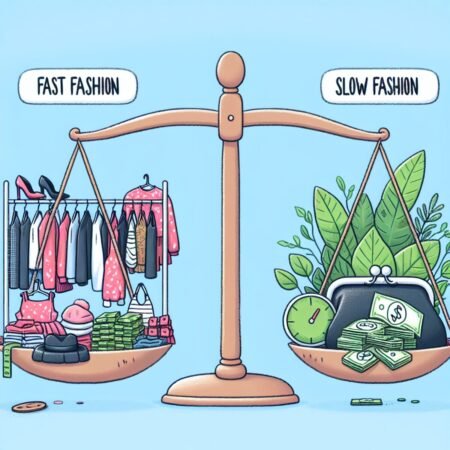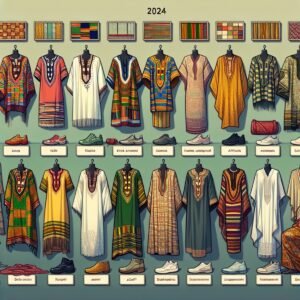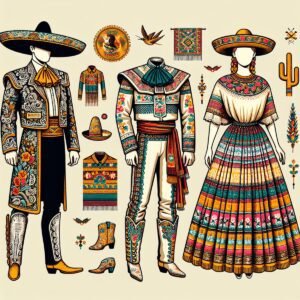
Introduction to Fast Fashion vs Slow Fashion
Fast fashion and slow fashion are two contrasting styles in the fashion industry that have gained significant attention in recent years. Fast fashion refers to a business model that emphasizes quick production and low prices, while slow fashion prioritizes sustainability, quality, and long-lasting garments.
The significance of discussing the impact of these two fashion styles on the environment and workers cannot be overstated. Fast fashion’s high-volume manufacturing and short product lifecycles have detrimental environmental consequences. The industry contributes to pollution, resource depletion, and waste generation. Additionally, garment workers in fast fashion supply chains often face exploitation and poor working conditions.
On the other hand, slow fashion aligns with sustainable practices by using eco-friendly fabrics, embracing innovative technologies, and advocating for transparency throughout the supply chain. Slow fashion brands prioritize fair wages and safe working conditions for artisans.
Understanding the differences between fast fashion and slow fashion is essential for consumers to make informed choices that benefit both their wallets and the planet. In this article, we will explore the negative impacts of fast fashion on the environment and workers, as well as the sustainable solutions offered by slow fashion.
Fast Fashion: The Dark Side of Cheap Trends

Fast fashion has become a dominant force in the fashion industry, offering consumers trendy and affordable clothing options. However, behind the allure of low prices and quick access to the latest trends lies a dark side that is often overlooked. In this section, we will delve into the various aspects of fast fashion that contribute to its negative impact on both the environment and garment workers.
Understanding the fast fashion business model
The fast fashion business model revolves around rapid production and low prices. Fast fashion brands prioritize speed over quality, aiming to quickly deliver inexpensive clothing to meet consumer demand for the latest trends. This model allows them to constantly introduce new styles into the market, encouraging consumers to buy more frequently.
The detrimental environmental consequences
The high-volume manufacturing associated with fast fashion has significant environmental repercussions:
- Mass production requires large quantities of resources such as water, energy, and raw materials.
- For example, it takes about 2,700 liters of water to produce a single cotton t-shirt, and that’s not even considering the water pollution caused by chemical dyes and treatments.
- Moreover, fast fashion thrives on short product lifecycles. Clothing items are designed to be worn only a few times before they fall out of style or disintegrate due to poor quality.
- As a result, vast amounts of clothing end up in landfills each year, contributing to waste accumulation and environmental degradation.
Exploitation and poor working conditions
The speed and cost-efficiency at which fast fashion garments are produced often come at the expense of garment workers’ rights and well-being:
- In pursuit of lower production costs, many fast fashion brands outsource their manufacturing processes to countries with lax labor laws and low wages.
- Garment workers in these supply chains endure exploitative working conditions, including long hours, unsafe environments, and insufficient wages.
- Tragically, incidents like the Rana Plaza collapse in Bangladesh in 2013, which claimed the lives of over 1,100 workers, serve as grim reminders of the human cost associated with fast fashion.
Consumer demand and its impact
The growth of the fast fashion industry is fueled by consumer demand for cheap and trendy clothing:
- The allure of low prices convinces consumers to buy more, resulting in excessive consumption and a culture of disposability.
- Many shoppers are enticed by the idea of having a constantly updated wardrobe without breaking the bank.
- Fast fashion brands capitalize on this consumer behavior by employing persuasive strategies such as limited-time offers, constant discounts, and influencer collaborations.
- These marketing tactics create a sense of urgency and encourage impulsive purchases, further driving the cycle of overconsumption.
Fast fashion’s business model prioritizes quick production and low prices at the expense of the environment and garment workers. The high-volume manufacturing and short product lifecycles lead to significant environmental damage, while exploitative working conditions persist in supply chains. Consumer demand for fast, cheap clothing continues to fuel
Slow Fashion: Where Sustainability Meets Style

The principles of slow fashion prioritize sustainability, quality, and long-lasting garments. This approach encourages consumers to invest in timeless pieces that are durable and can withstand the test of time, both in terms of style and functionality.
Sustainable Materials and Manufacturing
Eco-friendly fabrics and innovative technologies play a crucial role in the production of slow fashion items. Materials such as organic cotton, hemp, bamboo, and recycled fibers are commonly used to minimize the environmental impact of garment production. Additionally, advancements in dyeing processes and manufacturing techniques contribute to reducing water consumption and chemical usage in the creation of clothing.
Ethical Practices and Fair Trade
Ethical practices are at the core of slow fashion brands, reflecting a commitment to fair wages and safe working conditions for artisans. By aligning with certified fair trade organizations and ethical labor standards, these brands ensure that their employees are treated with dignity and respect throughout the production process.
Supply Chain Transparency
Transparency is a key value advocated by the slow fashion movement. Brands are urged to provide visibility into their entire supply chain, from sourcing materials to manufacturing processes. This transparency allows consumers to make informed decisions about the products they purchase, knowing that they align with their ethical and environmental values.
It’s not just about what you wear; it’s about how it’s made. Slow fashion embodies a mindful approach to dressing that extends beyond aesthetics, prioritizing the well-being of both people and the planet.
The Environmental Debate: Can Fast Fashion Ever Be Sustainable?
Fast fashion has become synonymous with a throwaway culture, where trends are swiftly produced, consumed, and discarded. This rapid cycle of clothing production and disposal contributes significantly to environmental pollution and resource depletion. The allure of low-cost, rapidly changing garments fuels this culture of disposability, perpetuating the cycle of overconsumption.
Exploring the concept of throwaway culture and its strong association with fast fashion consumption patterns.
Implementing circular fashion systems presents both challenges and opportunities for the fashion industry. These systems aim to minimize waste by promoting the reuse, recycling, and upcycling of products. In the context of fast fashion, embracing circularity entails rethinking traditional linear production models and shifting towards closed-loop systems. By extending the lifespan of garments through recycling initiatives or repurposing materials, fast fashion brands can begin to address their environmental impact.
Challenges and opportunities in implementing circular fashion systems to reduce waste and encourage product reuse/recycling in both fast and slow fashion sectors.
Slow fashion also stands to benefit from circularity by emphasizing durable, timeless designs that lend themselves to reimagining and repurposing. Encouraging consumers to invest in high-quality pieces that have longevity aligns with the principles of circular fashion. Additionally, supporting initiatives such as clothing swap events or repair workshops fosters a culture of sustainability within the slow fashion movement.
As the industry continues to grapple with the environmental implications of fast fashion, exploring circular solutions remains crucial. While challenges such as scaling up recycling infrastructure and altering consumer mindsets persist, the potential for reducing waste and minimizing environmental harm in both fast and slow fashion sectors is promising. Embracing circularity represents a pivotal step towards fostering sustainable practices within the fashion industry.
Examining the Social Impact: Who Pays the Price for Our Fashion Choices?
Contrasting Consumer Attitudes
Understanding how consumers view fast fashion trends compared to a more mindful approach to buying sustainable, ethically-made clothes can give us important information about the effects of our fashion choices:
- Fast fashion encourages impulse buying and constantly updating our wardrobes.
- Slow fashion promotes investing in timeless pieces that are made with sustainability and ethical production in mind.
The Difference in Working Conditions
One key aspect of how the fashion industry affects society is the noticeable difference in working conditions between fast fashion factories and slow fashion production units:
- Fast fashion factories often have unsafe environments where accidents can happen.
- Slow fashion brands prioritize creating safe workplaces and ensuring fair pay for their workers, as highlighted in this study on how fast fashion affects laborers and the environment.
Efforts to Improve the Fashion Industry
There are ongoing actions being taken to address human rights issues in the global fashion industry:
- Initiatives focused on international labor standards and certifications are being implemented.
- Organizations and advocacy groups are actively working to promote ethical practices and raise awareness about the challenges faced by garment workers in fast fashion centers.
The Importance of Consumer Awareness
By understanding consumer behavior, factory conditions, and human rights concerns related to both fast fashion and slow fashion, it becomes clear that we need to:
- Be more aware of how our shopping choices impact others, as discussed in this article on why fashion needs to be more sustainable.
- Hold brands accountable for their actions.
- Support initiatives that aim to create positive change within the industry.
Finding Balance: The Role of Consumers and Industry
In the fast fashion vs slow fashion debate, both consumers and the industry have a crucial role to play in creating a more sustainable and responsible fashion industry. By making conscious choices and supporting ethical brands, we can collectively work towards a better future for fashion. Here are some key points to consider:
1. Empowering consumers through education
One of the first steps towards finding balance is by empowering consumers with knowledge about the true cost of fast fashion and the benefits of investing in quality, timeless pieces. Educating consumers about the environmental and social impacts of their choices can help them make more informed decisions when it comes to their wardrobe.
2. Supporting local artisans and manufacturers
Another way consumers can contribute to a more sustainable fashion industry is by embracing slow fashion principles and buying from independent labels that prioritize local manufacturing partners. By doing so, consumers not only support local economies but also contribute to better salaries and working conditions for employees.
3. Collaborative approaches for positive change
Positive change requires collaboration between brands and consumers alike. Fashion rental services, for example, allow consumers to enjoy trendy outfits without having to buy new clothes every time. This reduces overall consumption and extends the lifecycle of garments. Additionally, clothing repair/alteration programs encourage consumers to mend or modify their existing clothes, promoting a culture of reuse and reducing waste.
By embracing these strategies, both consumers and the industry can work together to find a balance between fast fashion and slow fashion. It’s important to remember that it’s not about completely eliminating fast fashion but rather encouraging a shift towards more sustainable practices.
“The true power lies in our hands as consumers. By making conscious choices and supporting brands that align with our values, we can influence the industry towards positive change.”
Conclusion
The fashion industry is at a crucial point, needing to change its ways and prioritize sustainability and responsibility. It’s important to understand that fast and slow fashion can both exist together in this transformation. When we choose to support ethical brands, we are playing our part in protecting the environment and ensuring the welfare of workers.
To create a better future for fashion, we must take mindful actions as consumers and demand more openness from everyone involved. This includes knowing where our clothes come from, how they are made, and the impact they have on people and the planet.
It’s time to celebrate a fashion industry that combines style with sustainability, where every purchase reflects our values and beliefs. Together, we can make a difference and shape an industry that works for everyone.
FAQs (Frequently Asked Questions)
What is the significance of discussing the impact of fast fashion and slow fashion on the environment and workers?
The significance lies in understanding the environmental consequences and labor conditions associated with both fashion styles, which can help consumers and industry stakeholders make more informed and responsible choices.
What are the detrimental environmental consequences of fast fashion’s high-volume manufacturing and short product lifecycles?
Fast fashion’s high-volume manufacturing contributes to increased waste, pollution, and resource depletion, while short product lifecycles lead to rapid disposal of clothing, adding to the burden on landfills.
What are some prominent examples of ethical practices adopted by slow fashion brands?
Examples include fair wages and safe working conditions for artisans, as well as the use of eco-friendly fabrics and innovative technologies in production.
How can consumers be empowered to make more informed choices about their fashion purchases?
Consumers can be empowered through education about the true cost of fast fashion, the value of investing in quality pieces, and by supporting local artisans and manufacturers who embrace sustainable practices.
What are some collaborative approaches that involve both brands and consumers in driving positive change in the fashion industry?
Collaborative approaches include initiatives like fashion rental services, clothing repair/alteration programs, and supporting independent labels that prioritize sustainability and ethical production.
Why is there a need for a holistic shift towards a more sustainable and responsible fashion industry?
The need arises from the desire to create a better future for fashion by coexisting elements of both fast and slow fashion, supporting ethical brands, practicing mindful consumption, and demanding greater transparency from all stakeholders in the supply chain.







7 thoughts on “Fast Fashion vs Slow Fashion: Which Is Better for Your Wallet and the Planet?”